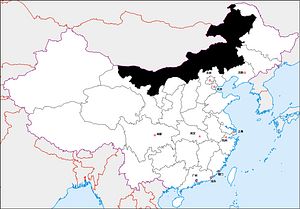This article series explores 12 distinct “regions” within China: six “core” regions long dominated by the majority Han ethnic group and six “periphery” regions home to many of China’s ethnic minorities. The series overview is available here. To view the full series, click here.
Separated from the independent nation of Mongolia by the vast Gobi, the deserts and grasslands of Inner Mongolia stretch from the Tibetan plateau’s northeast ramparts along the great bend of the Yellow River and toward China’s far northeast, where they are divided from Manchuria by the Greater Khingan mountains. For two millennia this region was contested between Chinese states and the steppe nomads; imperial China’s northern defense lines – equivalent to the Roman limes on the Rhine and Danube – roughly followed this frontier.
In the 1500s one of Genghis Khan’s lesser heirs built his power base in this area anchored by the city of Hohhot, which remains Inner Mongolia’s capital today. Altan Khan’s depredations spurred construction of the fortifications around Beijing that are now shown to tourists as the “Great Wall.” But he was also pivotal in spreading Buddhism among the Mongols through an alliance with the head of Tibet’s Gelugpa sect, upon whom he conferred the title of “Dalai Lama.”
Exploiting their patronage of Tibetan Buddhism, the Qing emperors of China secured the loyalty of the eastern Mongols. Today the descendants of these tribes are spread around Inner Mongolia’s 1.2 million square kilometers, and the region’s administrative districts still partly reflect organization under the Qing. For centuries the region has seen growing Han in-migration and administrative assertion, changing the ecology of the grasslands and putting pressure on the Mongol way of life, as vividly captured in the bestselling novel Wolf Totem.
With China’s 1911 revolution, Outer Mongolia declared independence, and was recognized as a sovereign state by the People’s Republic of China in 1949. During the 1930s the Japanese established a puppet state in Inner Mongolia, but their expansion in this area led to defeat at Soviet hands, with arguably momentous consequences for the course of World War II. In the 1960s-80s, Inner Mongolia was a closed and militarized region on the frontline of potential Soviet invasion. Today it has been overrun instead by Chinese tourists seeking a dude ranch-style Mongolian experience, although the Jiuquan space launch center in the region’s far west remains a restricted area.
Today, Inner Mongolia’s economy is based on primary industry, including a dominant share of global rare earths production. In the 21st century’s first decade, the region led the nation with annual growth rates breaking 15 percent, achieved through a mining boom and an infrastructure binge aimed at urbanizing the region, with the inevitable wastage epitomized in China’s most famous ghost city.
Rampant development, environmental destruction, and pressure on herders to resettle in urban centers has in recent years triggered sporadic unrest among ethnic Mongols. At the same time, burgeoning links with the independent nation of Mongolia, being developed as part of the state-led Belt and Road Initiative, are opening a new phase in the ancient relationship between the Mongol peoples and China.
Next up: Gansu and Ningxia.
John Lee is a former visiting fellow of the Mercator Institute for China Studies. He tweets at @J_B_C16.

































